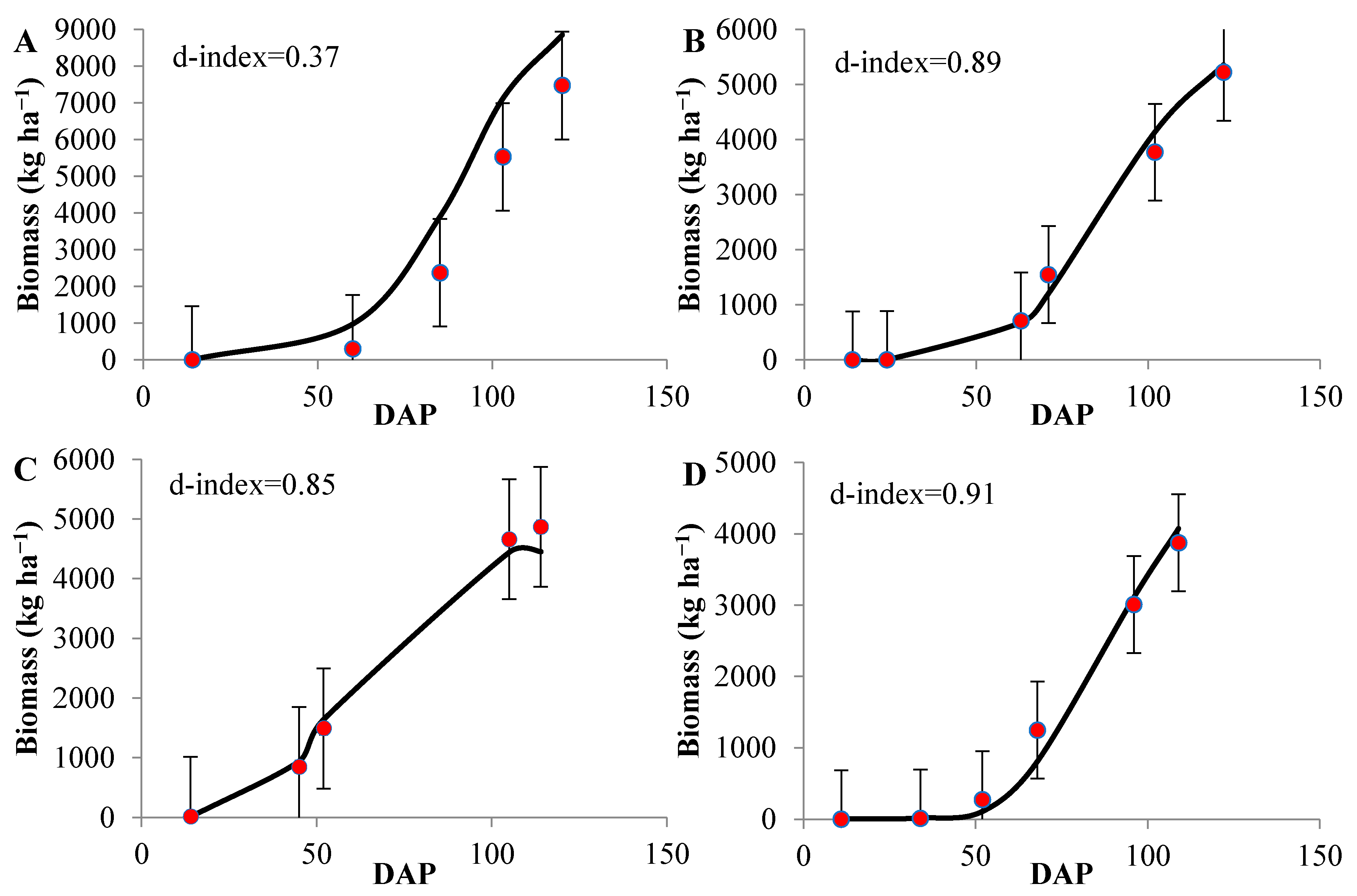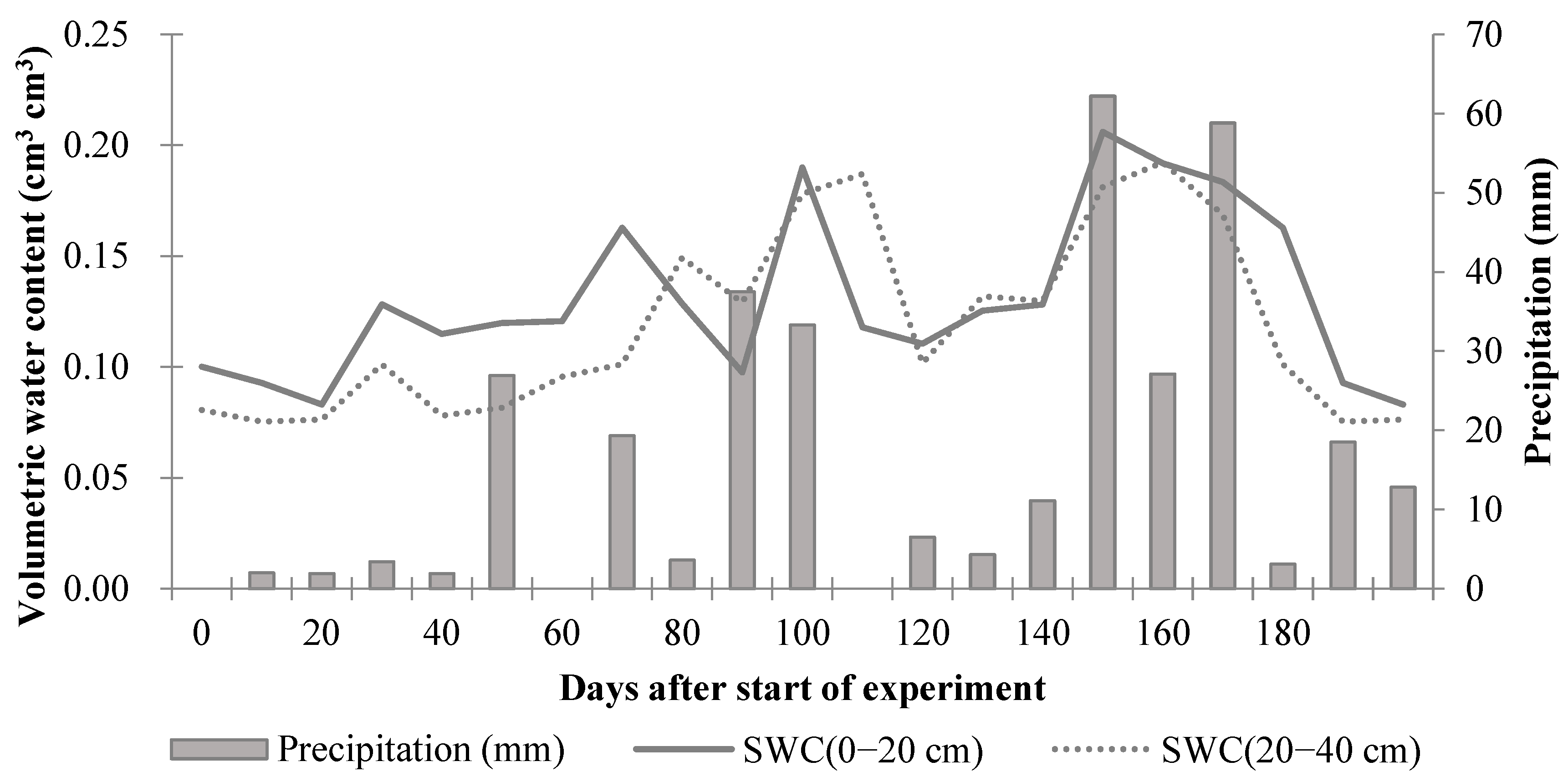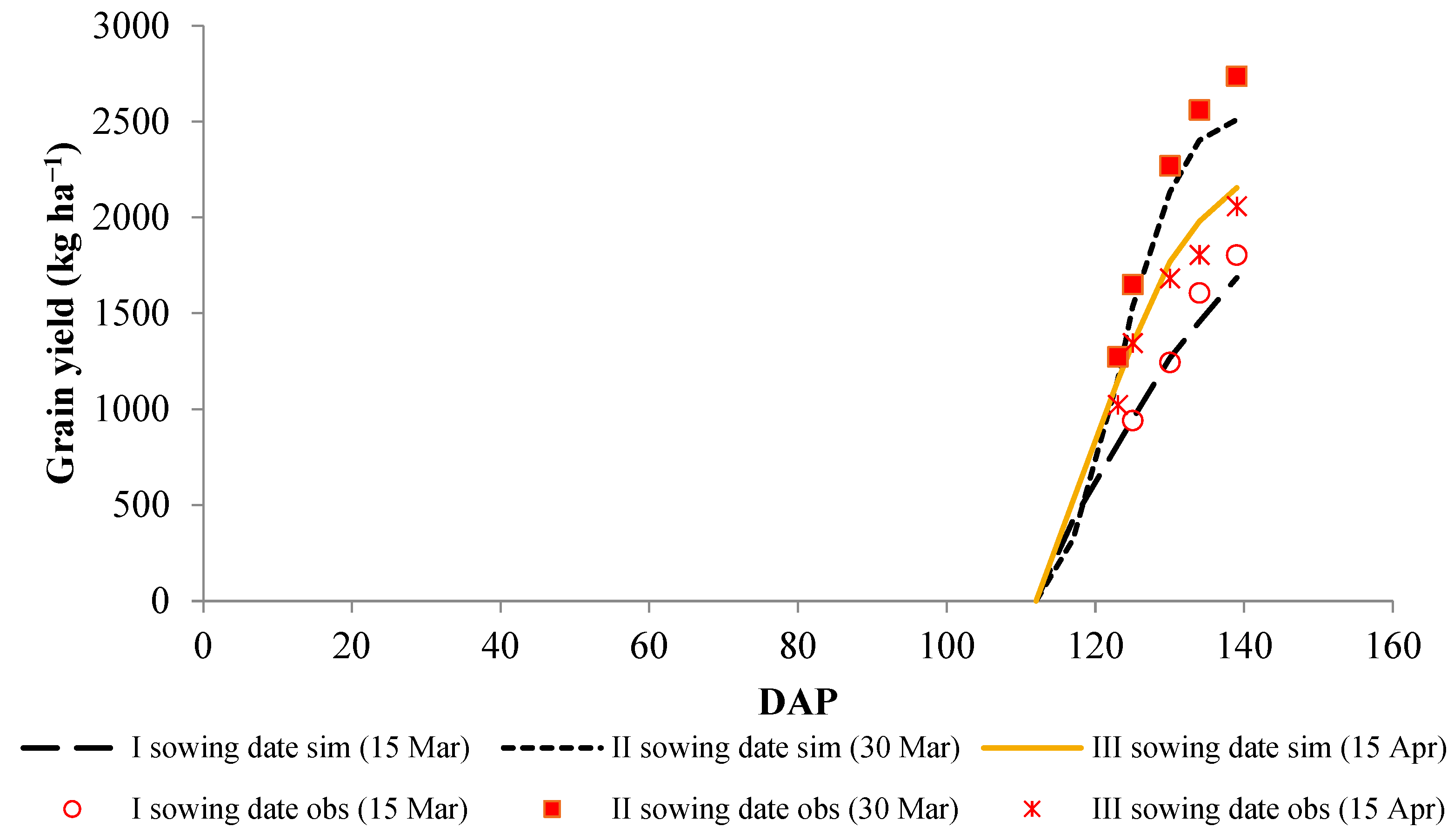Adaptation of the SIMPLE Model to Oilseed Flax (Linum usitatissimum L.) for Arid and Semi-Arid Environments
Abstract
:1. Introduction
2. Materials and Methods
2.1. Experimental Sites
2.2. Measurements of Soil Physicochemical Indexes
2.3. Weather Data of the Sites
2.4. Measurements of Flax Data
2.5. Model Introduction and Calibration
2.6. Statistical Index of Model Evaluation
3. Results
3.1. Flax Parameters in the SIMPLE Model
3.2. Calibration of SIMPLE-Flax Model
3.3. Evaluation of SIMPLE-Flax Model
3.4. Effect of Sowing Date at the Dingxi Site
4. Discussion
5. Conclusions
Author Contributions
Funding
Acknowledgments
Conflicts of Interest
References
- Povkhova, L.V.; Melnikova, N.V.; Rozhmina, T.A.; Novakovskiy, R.O.; Pushkova, E.N.; Dvorianinova, E.M.; Zhuchenko, A.A.; Kamionskaya, A.M.; Krasnov, G.S.; Dmitriev, A.A. Genes associated with the flax plant type (oil or fiber) identified based on genome and transcriptome sequencing data. Plants 2021, 10, 2616. [Google Scholar] [CrossRef] [PubMed]
- Xie, Y.P.; Gan, Y.T.; Li, Y.; Niu, J.Y.; Gao, Y.H.; An, H.H.; Li, A.R. Effect of nitrogen fertilizer on nitrogen accumulation, translocation, and use efficiency in dryland oilseed flax. Agron. J. 2015, 107, 1931–1939. [Google Scholar] [CrossRef]
- Shekhara, N.R.; Anurag, A.P.; Prakruthi, M.; Mahesh, M.S. Flax Seeds (Linum usitatissimmum): Nutritional composition and health benefits. IP J. Nutr. Metab. Health Sci. 2020, 3, 35–40. [Google Scholar]
- Hall, C.; Tulbek, M.C.; Xu, Y.Y. Flaxseed. Adv. Food Nutr. Res. Acad. Press 2006, 51, 1–97. [Google Scholar] [CrossRef]
- Kumar, S.; Jordan, M.C.; Datla, R.; Cloutier, S. The LuWD40-1 Gene Encoding WD Repeat Protein Regulates Growth and Pollen Viability in Flax (Linum Usitatissimum L.). PLoS ONE 2013, 8, e69124. [Google Scholar] [CrossRef] [PubMed]
- Saleem, M.H.; Ali, S.; Hussain, S.; Kamran, M.; Chattha, M.S.; Ahmad, S.; Aqeel, M.; Rizwan, M.; Aljarba, N.H.; Alkahtani, S.; et al. Flax (Linum usitatissimum L.): A potential candidate for phytoremediation? Biological and economical points of view. Plants 2020, 9, 496. [Google Scholar] [CrossRef] [PubMed] [Green Version]
- Yu, Z.W. On Crop Cultivation (Northern Edition); China Agricultural Press: Beijing, China, 2003; pp. 32–369. [Google Scholar]
- Hoogenboom, G.; Porter, C.H.; Boote, K.J.; Shelia, V.; Wilkens, P.W.; Singh, U.; White, J.W.; Asseng, S.; Lizaso, J.I.; Moreno, L.P.; et al. The DSSAT crop modeling ecosystem. In Advances in Crop Modeling for a Sustainable Agriculture; Boote, K.J., Ed.; Burleigh Dodds Science Publishing: Cambridge, UK, 2019; pp. 173–216. [Google Scholar]
- Hoogenboom, G.; Porter, C.H.; Shelia, V.; Boote, K.J.; Singh, U.; White, J.W.; Hunt, L.A.; Ogoshi, R.; Lizaso, J.I.; Koo, J.; et al. Decision Support System for Agrotechnology Transfer (DSSAT) Version 4.7; DSSAT Foundation: Gainesville, FL, USA, 2017. [Google Scholar]
- Jones, J.W.; Hoogenboom, G.; Porter, C.H.; Boote, K.J.; Batchelor, W.D.; Hunt, L.A.; Wilkens, P.W.; Singh, U.; Gijsman, A.J.; Ritchie, J.T. DSSAT Cropping System Model. Eur. J. Agron. 2003, 18, 235–265. [Google Scholar] [CrossRef]
- Kiniry, J.R.; Williams, J.R.; Major, D.J.; Izaurralde, R.C.; Gassman, P.W.; Morrison, M.; Bergentine, R.; Zentner, R.P. EPIC model parameters for cereal, oilseed, and forage crops in the northern great plains region. Can. J. Plant Sci. 1995, 75, 679–688. [Google Scholar] [CrossRef]
- Habekotté, B. A model of the phenological development of winter oilseed rape (Brassica napus L.). Field Crops Res. 1997, 54, 127–136. [Google Scholar] [CrossRef]
- Gabrielle, B.; Denoroy, P.; Gosse, G.; Justes, E.; Andersen, M.N. Development and evaluation of a CERES-type model for winter oilseed rape. Field Crops Res. 1998, 57, 95–111. [Google Scholar] [CrossRef]
- Robertson, M.J.; Holland, J.F.; Kirkegaard, J.A.; Smith, C.J. Simulating growth and development of canola in Australia. In Proceedings of the 10th International Rapeseed Congress, Canberra, Australia, 26–29 September 1999. [Google Scholar]
- Robertson, M.J.; Lilley, J.M. Simulation of growth, development and yield of canola (Brassica napus) in APSIM. Crop Pasture Sci. 2016, 67, 332–344. [Google Scholar] [CrossRef]
- Deligios, P.A.; Farci, R.; Sulas, L.; Hoogenboom, G.; Ledda, L. Predicting growth and yield of winter rapeseed in a Mediterranean environment: Model adaptation at a field scale. Field Crops Res. 2013, 144, 100–112. [Google Scholar] [CrossRef]
- Gilardelli, C.; Stella, T.; Frasso, N.; Cappelli, G.; Bregaglio, S.; Chiodini, M.E.; Scaglia, B.; Confalonieri, R. WOFOST-GTC: A new model for the simulation of winter rapeseed production and oil quality. Field Crops Res. 2016, 197, 125–132. [Google Scholar] [CrossRef]
- Liu, H.; Jin, Z.Q. A phenological model to simulate rape development. Q. J. Appl. Meteorol. 2003, 14, 634–640. [Google Scholar]
- Cao, H.X.; Zhang, C.L.; Li, G.M.; Zhang, B.J.; Zhao, S.L.; Wang, B.Q.; Jin, Z.Q.; Gao, L.Z. Researches of simulation models of rape (Brassica napus L.) growth and development. Acta Agron. Sin. 2006, 32, 1530–1536. [Google Scholar]
- Liu, T.M.; Hu, L.Y.; Zhao, Z.H.; Cao, C.G.; Cao, W.X.; Yan, M.C. A mechanistic of phasic and phenological development in rape I. Description of the model. Chin. J. Oil Sci. 2004, 26, 28–32. [Google Scholar]
- Tang, L.; Zhu, Y.; Liu, T.M.; Cao, W.X. A process-based model for simulating phenological development in rapeseed. Sci. Agric. Sin. 2008, 41, 2493–2498. [Google Scholar]
- Rahimi-Moghaddam, S.; Eyni-Nargeseh, H.; Kalantar Ahmadi, S.A.; Azizi, K. Towards withholding irrigation regimes and drought-resistant genotypes as strategies to increase canola production in drought-prone environments: A modeling approach. Agric. Water Manag. 2021, 243, 106487. [Google Scholar] [CrossRef]
- Sun, B.; Wang, C.F.; Yang, C.H.; Xu, B.D.; Zhou, G.S.; Li, X.Y.; Xie, J.; Xu, S.J.; Liu, B.; Xie, T.J.; et al. Retrieval of rapeseed leaf area index using the PROSAIL model with canopy coverage derived from UAV images as a correction parameter. Int. J. Appl. Earth Obs. Geoinf. 2021, 102, 102373. [Google Scholar] [CrossRef]
- Qian, B.D.; Jing, Q.; Bélanger, G.; Shang, J.L.; Huffman, T.; Liu, J.G.; Hoogenboom, G. Simulated canola yield responses to climate change and adaptation in Canada. Agron. J. 2018, 110, 133–146. [Google Scholar] [CrossRef] [Green Version]
- Li, Y.; Wu, L.; Gao, Z.N.; Niu, J.Y. Simulation model of photosynthesis and dry matter accumulation in oilseed flax based on APSIM. Acta Prataculturae Sin. 2018, 27, 57–66. [Google Scholar] [CrossRef]
- Li, Y.; Wu, B.; Liu, D.; Gao, Z.N.; Xie, Y.P.; Yan, B.; Zhang, Z.K.; Niu, J.Y. Simulation model for flax yield formation of oilseed flax based on APSIM. Chin. J. Eco Agric. 2016, 24, 1246–1253. [Google Scholar] [CrossRef]
- Li, Y.; Niu, J.Y.; Xie, Y.P.; Wu, B.; Gao, Z.N.; Liu, D.; Yan, B. Simulation of oilseed flax leaf area index based on APSIM. Chin. J. Oil Crop Sci. 2015, 37, 329–335. [Google Scholar] [CrossRef]
- Li, Y.; Niu, J.Y.; Wu, B.; Xie, Y.P.; Yan, B. Simulation oilseed flax development duration based on APSIM. J. Nucl. Agric. Sci. 2015, 29, 972–979. [Google Scholar] [CrossRef]
- Li, Y.; Niu, J.Y.; Guo, L.Z. Application and validation of AquaCrop model in simulating biomass and yield of oil flax in Northwest China. Chin. J. Eco Agric. 2014, 22, 93–103. [Google Scholar] [CrossRef]
- Zhao, C.; Liu, B.; Xiao, L.J.; Hoogenboom, G. A SIMPLE crop model. Eur. J. Agron. 2019, 104, 97–106. [Google Scholar] [CrossRef]
- Ahmed, M. Systems Modeling; Springer: Singapore, 2020; pp. 1–44. [Google Scholar] [CrossRef]
- National Soil Survey Office (NSSO). Chinese Soil; China Agriculture Press: Beijing, China, 1998; pp. 32–140. [Google Scholar]
- Tiver, N.S.; Williams, R.F. Studies of the flax plant. II. The effect of artificial drought on growth and oil production in a linseed variety. Aust. J. Exp. Biol. Med. Sci. 1943, 21, 202. [Google Scholar] [CrossRef]
- Gusta, L.V.; O’Connor, B.J.; Bhatty, R.S. Flax (Linum usitatissimum L.) responses to chilling and heat stress on flowering and seed yield. Can. J. Plant Sci. 1997, 77, 97–99. [Google Scholar] [CrossRef]
- Li, X.; Fang, Z.; Niu, J. Study on configuration fabric and germination conditions of flax seed. Seed 2012, 31, 26–30. [Google Scholar] [CrossRef]
- Kraft, J.M.; Kommedahl, T.; Linck, A.L. Histological study of malformation in flaxseed after exposure to 31 °C. Bot. Gaz. 1963, 125, 367–371. [Google Scholar] [CrossRef]
- Darapuneni, M.; Morgan, G.D.; Ibrahim, A.M.H.; Duncan, R.W. Effect of vernalization and photoperiod on flax flowering time. Euphytica 2014, 195, 279–285. [Google Scholar] [CrossRef]
- Yermanos, D.M.; Goodin, J.R. Temperature effects: On vegetative growth and oil quality of FLAX. Calif. Agric. 1965, 19, 15–16. [Google Scholar] [CrossRef]
- Monteith, J.L. Light distribution and photosynthesis in field crops. Ann. Bot. 1965, 29, 17–37. [Google Scholar] [CrossRef]
- Amir, J.; Sinclair, T.R. A model of water limitation on spring wheat growth and yield. Field Crops Res. 1991, 28, 59–69. [Google Scholar] [CrossRef]
- Kanda, E.K.; Senzanje, A.; Mabhaudhi, T. Calibration and validation of AquaCrop model for full and deficit irrigated cowpea (Vigna unguiculata (L.)) Walp). Phys. Chem. Earth Parts A/B/C 2021, 124 Pt 1, 102941. [Google Scholar] [CrossRef]
- Willmott, C.J. Some comments on the evaluation of model performance. B Am. Meteorol. Soc. 1982, 63, 1309–1313. [Google Scholar] [CrossRef] [Green Version]
- Deihimfard, R.; Rahimi-Moghaddam, S.; Collins, B.; Azizi, K. Future climate change could reduce irrigated and rainfed wheat water footprint in arid environments. Sci. Total Environ. 2022, 807 Pt 3, 150991. [Google Scholar] [CrossRef]
- Elnashar, A.; Wang, L.; Wu, B.; Zhu, W.; Zeng, H. Synthesis of global actual evapotranspiration from 1982 to 2019. Earth Syst. Sci. Data 2020, 13, 447–480. [Google Scholar] [CrossRef]
- Singh, S.; Boote, K.J.; Angadi, S.V.; Grover, K.; Begna, S.; Auld, D. Adapting the CROPGRO model to simulate growth and yield of spring safflower in semiarid conditions. Agron. J. 2016, 108, 64–72. [Google Scholar] [CrossRef]
- Xue, L. Study of Development Simulation Models in Sesame. Master’s Thesis, Nanjing Agricultural University, Nanjing, China, 2012. [Google Scholar] [CrossRef]
- De Wit, C.T. Photosynthesis of Leaf Canopies; Agricultural Research Reports; Pudoc: Wageningen, The Netherlands, 1965; pp. 1–54. Available online: https://edepot.wur.nl/187115 (accessed on 1 November 2019).
- Duncan, W.G.; Loomis, R.S.; Williams, W.A.; Hanau, R. A model for simulating photosynthesis in plant communities. Hilgardia 1967, 38, 181–205. [Google Scholar] [CrossRef] [Green Version]
- Tang, L.Y.; Hou, C.; Huang, H.Y.; Chen, C.C.; Zou, J.; Lin, D. Light interception efficiency analysis based on three-dimensional peach canopy models. Ecol. Inf. 2015, 30, 60–67. [Google Scholar] [CrossRef] [Green Version]
- Chen, Q.; Baldocchi, D.; Gong, P.; Dawson, T. Modeling radiation and photosynthesis of a heterogeneous savanna woodland landscape with a hierarchy of model complexities. Agric. For. Meteorol. 2008, 148, 1005–1020. [Google Scholar] [CrossRef]
- Wen, W.L.; Guo, X.Y.; Li, B.J.; Wang, C.Y.; Wang, Y.J.; Yu, Z.T.; Wu, S.; Fan, J.C.; Gu, S.H.; Lu, X.J. Estimating canopy gap fraction and diffuse light interception in 3D maize canopy using hierarchical hemispheres. Agric. For. Meteorol. 2019, 276–277, 107594. [Google Scholar] [CrossRef]
- Bing, F. Research on the agriculture intelligent system based on IOT. In Proceedings of the 2012 International Conference on Image Analysis and Signal Processing, Huangzhou, China, 9–11 November 2012; pp. 1–4. [Google Scholar] [CrossRef]
- Liu, T.M. Simulation on Photosynthetic Production and Dry Matter Partitioning in Wheat. Ph.D. Thesis, Nanjing Agricultural University, Nanjing, China, 2000. [Google Scholar] [CrossRef]
- Zhang, L.Z.; Cao, W.X.; Zhang, S.P.; Luo, W.H. A process model of photosynthetic production and dry matter accumulation in cotton. Cotton Sci. 2003, 15, 138–145. [Google Scholar]
- Zhu, Y.J.; Feng, L.P.; Yi, P. A dynamic model simulating photosynthetic production and dry matter accumulation for alfalfa (Medicago sativa L.). Acta Agron. Sin. 2007, 33, 1682–1687. [Google Scholar] [CrossRef]
- Zhang, Y.J. Study on Direct-Seeding Rapeseed Growth Simulation Model. Master’s Thesis, Huazhong Agricultural University, Wuhan, China, 2013. [Google Scholar] [CrossRef]
- Zou, W. A Process-Based Simulation Model on Barley Growth and Development. Ph.D. Thesis, Nanjing Agricultural University, Nanjing, China, 2009. [Google Scholar] [CrossRef]
- Yang, J.M.; Yang, J.Y.; Liu, S.; Hoogenboom, G. An evaluation of the statistical methods for testing the performance of a crop simulation model with observed data. Agric. Syst. 2014, 127, 81–89. [Google Scholar] [CrossRef]
- Hoogenboom, G. Contribution of agrometeorology to the simulation of crop production and its applications. Agric. Forest Meteorol. 2020, 103, 137–157. [Google Scholar] [CrossRef]
- Boote, K.J.; Jones, J.W.; Hoogenboom, G. Crop simulation models as tools for agro-advisories for weather and disease effects on production. J. Agrometeorol. 2008, 10, 9–17. [Google Scholar]
- Tsuji, G.Y.; Hoogenboom, G.; Thornton, P.K. Part of the Systems Approaches for Sustainable Agricultural Development book series (SAAD). In Understanding Options for Agricultural Production; Kluwer Academic Publishers: Dordrecht, The Netherlands, 1998; Volume 7, p. 400. [Google Scholar]









| Feature | Dingxi | Zhangjiakou | Wulanchabu | Datong |
|---|---|---|---|---|
| Provinces of China | Gansu | Hebei | Inner Mongolia | Shanxi |
| Average elevation (m) | 2050 | 1450 | 1419 | 1067 |
| Longitude and latitude | 104°37′12″ E, 35°34′48″ N | 104°10′ E, 40°57′ N | 113°0′ E, 41°9′ N | 113°20′ E, 40°6′ N |
| Average total annual rainfall (mm) | 300–400 | 392 | 150–450 | 392.7 |
| Average annual temperature (°C) | 3.2 | 6.6 | 7.8 | 5.7 |
| Average annual frost-free period (days) | 146 | 125 | 110 | 135 |
| Flax cultivar | Longya Hybrid No. 1 | Baxuan No. 3 | Longya Hybrid No. 1 | Zhangya No. 2 |
| Sowing date | 23 April 2017; 9 April 2018; 15 March 2020; 30 March 2020; 15 April 2020; | 5 May 2017; 6 May 2018 | 10 May 2016; 5 May 2017 | 24 April 2016; 19 April 2017 |
| Harvesting date | 20 August 2017; 10 August 2018; 1 August 2020; 8 August 2020; 27 August 2020; | 3 September 2017; 8 September 2018 | 12 September 2016; 7 September 2017 | 10 August 2016; 2 September 2017 |
| Sites | Soil Type | Soil Texture | Soil Depth (cm) | AWC (mm) | RCN | DDC | RZD (mm) |
|---|---|---|---|---|---|---|---|
| Dingxi | Dark Loessial soil | Clay loam | 0–21 | 0.12 | 80 | 0.3 | 700 |
| Wulanchabu and Datong | Castanozems | Clay loam | 0–40 | 0.19 | 75 | 0.3 | 1300 |
| Zhangjiakou | Sandy loam | Sandy clay loam | 0–20 | 0.13 | 75 | 0.6 | 550 |
| Parameter | Unit | Value | Source of Data |
|---|---|---|---|
| Tbase | °C | 4.5–5 | [7] |
| Topt | °C | 20–25 | [7,35] |
| RUE | g MJ−1m−2 | 0.86–1.09 | Calibrated |
| I50maxH | °C day | 110 ± 2 | Calibrated |
| I50maxW | °C day | 18 ± 2 | Calibrated |
| Tmax | °C | 36 | [36] |
| Text | °C | 45 | [36] |
| SCO2 | -- | 0.07 | [30] |
| Swater | -- | 0.9 | [30] |
| Sites | Cultivar | Tsum | HI | I50A | I50B | Source of Data |
|---|---|---|---|---|---|---|
| Dingxi and Wulanchabu | Longya Hybrid No. 1 | 2350 | 0.30 | 530 | 500 | Calibrated |
| Datong | Zhangya No. 2 | 2850 | 0.43 | 600 | 550 | Calibrated |
| Zhangjiakou | Baxuan No. 3 | 2285 | 0.30 | 680 | 650 | Calibrated |
| Site | Year | Biomass | Grain Yield | fSolar | ||
|---|---|---|---|---|---|---|
| RMSE (kg ha−1) | d-Index | RMSE (kg ha−1) | RRMSE (%) | RMSE | ||
| Dingxi | 2017 | 612 | 0.37 | 85 | 3.3 | 0.396 |
| Zhangjiakou | 2017 | 213 | 0.89 | 48 | 2.9 | 0.208 |
| Wulanchabu | 2016 | 225 | 0.85 | 46 | 3.3 | 0.448 |
| Datong | 2016 | 212 | 0.91 | 212 | 13.8 | 0.435 |
| Site | Year | Biomass | Yield | fSolar | ||
|---|---|---|---|---|---|---|
| RMSE (kg h−1) | d-Index | RMSE (kg ha−1) | RRMSE (%) | RMSE | ||
| Dingxi | 2018 | 1239 | 0.69 | 55 | 2 | 0.440 |
| Zhangjiakou | 2018 | 135 | 0.90 | 5 | 0.4 | 0.530 |
| Wulanchabu | 2017 | 280 | 0.95 | 63 | 4.8 | 0.669 |
| Datong | 2017 | 140 | 0.97 | 176 | 9.1 | 0.544 |
Publisher’s Note: MDPI stays neutral with regard to jurisdictional claims in published maps and institutional affiliations. |
© 2022 by the authors. Licensee MDPI, Basel, Switzerland. This article is an open access article distributed under the terms and conditions of the Creative Commons Attribution (CC BY) license (https://creativecommons.org/licenses/by/4.0/).
Share and Cite
Li, Y.; Hoogenboom, G.; Asseng, S.; Niu, J.-Y.; Wu, L.; Kang, L.-H. Adaptation of the SIMPLE Model to Oilseed Flax (Linum usitatissimum L.) for Arid and Semi-Arid Environments. Agronomy 2022, 12, 1267. https://doi.org/10.3390/agronomy12061267
Li Y, Hoogenboom G, Asseng S, Niu J-Y, Wu L, Kang L-H. Adaptation of the SIMPLE Model to Oilseed Flax (Linum usitatissimum L.) for Arid and Semi-Arid Environments. Agronomy. 2022; 12(6):1267. https://doi.org/10.3390/agronomy12061267
Chicago/Turabian StyleLi, Yue, Gerrit Hoogenboom, Senthold Asseng, Jun-Yi Niu, Ling Wu, and Liang-He Kang. 2022. "Adaptation of the SIMPLE Model to Oilseed Flax (Linum usitatissimum L.) for Arid and Semi-Arid Environments" Agronomy 12, no. 6: 1267. https://doi.org/10.3390/agronomy12061267
APA StyleLi, Y., Hoogenboom, G., Asseng, S., Niu, J.-Y., Wu, L., & Kang, L.-H. (2022). Adaptation of the SIMPLE Model to Oilseed Flax (Linum usitatissimum L.) for Arid and Semi-Arid Environments. Agronomy, 12(6), 1267. https://doi.org/10.3390/agronomy12061267






